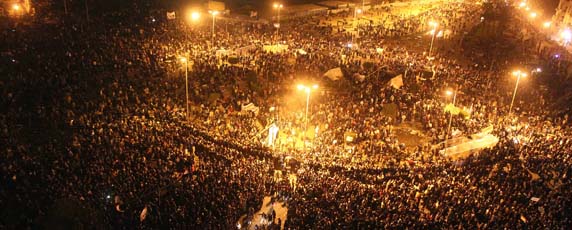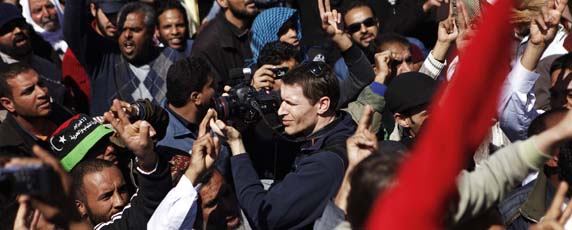Murders decline, but fatalities rise during coverage of protests. Photographers and freelancers pay an especially high price. Pakistan is the world’s most dangerous nation.
Risks Shift as Coverage of Political Unrest Proves Deadly
Pakistan remained the deadliest country for the press for a second year, while across the world coverage of political unrest proved unusually dangerous in 2011. CPJ’s analysis found notable shifts from historical data: Targeted murders declined while deaths during dangerous assignments such as the coverage of street protests reached their highest level on record. Photographers and camera operators, often the most vulnerable during violent unrest, died at rates more than twice the historical average.

At least 46 journalists were killed around the world in direct relation to their work in 2011, with the seven deaths in Pakistan marking the heaviest losses in a single nation. Libya and Iraq, each with five fatalities, and Mexico, with three deaths, also ranked high worldwide for journalism- related fatalities. The global tally is consistent with the toll recorded in 2010, when 44 journalists died in connection with their work. CPJ is investigating another 35 deaths in 2011 to determine whether they were work-related.
CPJ’s survey identified significant changes in the nature of journalist fatalities. Seventeen journalists died while on dangerous assignments, many of them while covering the chaotic and violent confrontations between authorities and protesters during the uprisings that swept the Arab world. The victims included Hassan al-Wadhaf, a Yemeni cameraman shot by a sniper while covering anti-government protests in Sana’a, and Ahmad Mohamed Mahmoud, an Egyptian reporter gunned down while filming a protest in Cairo. “Journalists working in this environment are in no less danger than war correspondents covering an armed conflict,” said Ahmed Tarek, a reporter for the Middle East News Agency who was assaulted by police while covering protests in Alexandria, Egypt. “The greatest danger journalists are facing today in post-revolution Arab countries is the targeting of journalists by political forces hostile to anyone who exposes them.”
The 21 murders recorded in 2011 were the lowest total since 2002. Targeted murders–which historically account for nearly three-quarters of journalist deaths–constituted less than half of the 2011 toll. But murders were reported in both Russia and the Philippines, two countries long plagued by deadly, anti-press violence. In the southern Russian republic of Dagestan, an assassin waited outside the offices of the critical independent newspaper Chernovik and gunned down its founder, Gadzhimurad Kamalov. In the Philippines, CPJ documented the work-related murders of two radio commentators. One of them, Romeo Olea, was shot in the back while riding his motorcycle to work. CPJ is waging a Global Campaign Against Impunity that focuses particularly on those two countries.

Eight journalists died in combat situations in 2011, most of them during the Libyan revolution. The victims included the internationally acclaimed photojournalists Chris Hondros and Tim Hetherington, who were killed by a mortar round in the western city of Misurata, and Ali Hassan al-Jaber, a cameraman for Al-Jazeera who was shot outside Benghazi by forces loyal to Muammar Qaddafi. The Libyan conflict was “one of the truly televised revolutions,” said James Foley, an American video journalist for Global Post who was detained there in April. “Everyone was using a camera–and a camera is much more recognizable.”
Photojournalists suffered particularly heavy losses in 2011. Photographers and camera operators constituted about 40 percent of the overall death toll, about double the proportion CPJ has documented since it began keeping detailed fatality records in 1992. Among those killed was Lucas Mebrouk Dolega, a photographer for European Pressphoto Agency who was struck by a tear gas canister fired by security forces trying to quell a massive January protest that led to the ouster of President Zine El Abidine Ben Ali.
Nine online journalists were killed for their work during the year. Among the victims was Mexican reporter Maria Elizabeth Macías Castro, whose decapitated body was found near the city of Nuevo Laredo, along with a note saying she had been killed for reporting news on social media websites. Her murder was the first documented by CPJ worldwide that came in direct relation to journalism published on social media. The online death toll also included Mohammed al-Nabbous, founder of the website Libya Al-Hurra TV, who was killed while covering a battle in Benghazi. Al-Nabbous had been streaming live audio from the scene of the battle when his feed was suddenly interrupted by gunfire.
Internet journalists rarely appeared on CPJ’s death toll before 2008. But since that time, as online journalists constitute an ever-greater proportion of the front-line reporting corps, the number of victims who worked online has increased steadily.
CPJ’s analysis also found a high proportion of freelancers among the 2011 victims. One-third of the toll was composed of freelance journalists, more than twice the proportion that freelancers have constituted over time. Azerbaijani freelance reporter Rafiq Tagi died in November after being stabbed on a Baku street. He had been threatened over his critical coverage of both Islamist politics and government policies.

Anti-press violence continued at high levels in Pakistan, where 29 journalists have died in direct relation to their work in the past five years. The 2011 victims included Saleem Shahzad, a reporter for Asia Times Online, who was murdered after exposing links between Al-Qaeda and Pakistan’s navy. Five of the seven fatalities in Pakistan were targeted murders, and all are unsolved. Long-term CPJ research shows Pakistan to be among the worst countries in the world in bringing the killers of journalists to justice. “The solution is simple and very difficult at the same time,” said Pakistani reporter Umar Cheema, who was himself abducted and brutally assaulted in 2010. “The government should be taking it seriously and realize it is their duty to protect journalists. If a journalist is threatened, the culprit should be brought to justice. Even if in one case the culprits were brought to justice, that would be a clear message that the crime will not go unpunished.”
The death toll in Libya, while high, was unsurprising given the armed revolt and overall level of violence. That Iraq, with five deaths, matched Libya’s fatality rate illustrates the entrenched level of violence in that country. After record death tolls in the middle part of the last decade, fatalities in Iraq began dropping in 2008. But deaths have levelled out in recent years as journalists continued to die in both targeted murders and insurgent attacks such as the March assault on a provincial government building in Tikrit that took the lives of reporters Sabah al-Bazi and Muammar Khadir Abdelwahad.
In Mexico, CPJ documented three deaths in direct relation to journalism and was investigating the killings of four other journalists. Mexican authorities appeared paralyzed in their efforts to combat pervasive anti-press violence; Congress continued to debate legislation in late year that would federalize crimes against free expression, taking the cases out of the hands of local officials who have been corrupted and cowed by criminal gangs. Mexican journalists continue to face a dark choice: Censor their own work or be at risk. Noel López Olguín, whose newspaper column “With a Lead Pen” took on drug trafficking and official corruption, was found in a clandestine grave in Veracruz state in May, two months after gunmen had abducted him.
Afghanistan and Somalia, two conflict-ridden countries with persistent levels of anti-press violence, each recorded fatalities in 2011. CPJ documented the deaths of two journalists and one media worker in Somalia, along with the killings of two journalists in Afghanistan. Two of the deaths, though a continent apart, bore similarities that illustrate the extreme danger of covering conflict. In Somalia, African Union troops fired on a humanitarian aid convoy, killing Malaysian cameraman Noramfaizul Mohd. The AU called the shooting accidental but released no details. In Afghanistan, a U.S. soldier shot Ahmad Omaid Khpalwak, a correspondent for Pajhwok Afghan News and the BBC, during an insurgent attack in Tarin Kot. The International Security Assistance Force in Afghanistan concluded that the soldier mistook Khpalwak’s press card for a bomb trigger.
Two journalists died in Bahraini government custody. Karim Fakhrawi, a founder of the independent newspaper Al-Wasat, and Zakariya Rashid Hassan al-Ashiri, editor of a local news website in the village of Al-Dair, died within a week of each other in April. Although the government claimed the two died of natural causes, there were widespread allegations that abusive treatment led to their deaths. Al-Wasat co-founder Mansoor al-Jamri said the death of Fakhrawi was a message from the government to its critics: “This could happen to you, and no one will protect you, and no one can do anything for you.”
Here are other trends and details that emerged in CPJ’s analysis:
- The heaviest losses occurred in nations across the Middle East and North Africa, where CPJ documented 19 work-related fatalities in all. Thirteen work-related deaths were documented in Asia, eight in the Americas, four in Africa, and two in Europe and Central Asia.
- In two countries, Tunisia and Syria, CPJ recorded the first work-related deaths since it began compiling detailed data two decades ago. In Syria, freelance cameraman Ferzat Jarban was tortured and slain in Homs province after he had covered antigovernment demonstrations. “The work of a reporter in Syria before and after the protests is much like working in a minefield,” said Karim al-Afnan, a freelance journalist who was forced into exile in 2011. “The state views a journalist as a rival and their battle with journalists is one for survival.”
- Five media support workers were killed worldwide. They include the Ivorian Marcel Legré, a printing press employee who was killed by supporters of Alassane Ouattara who at the time was locked in a presidential election dispute with incumbent Laurent Gbagbo. Legré’s newspaper was seen as pro-Gbagbo.
- At least two journalists were reported missing during the year, both in Mexico. At least 11 journalists have been reported missing in Mexico over the past decade, by far the highest number worldwide. All are feared dead.
- Among murder victims, more than 70 percent had reported receiving threats in the weeks before they died. Long-term CPJ research shows that physical attacks are often preceded by phone or electronic threats.
- Other places with confirmed, work- related fatalities were Brazil, Nigeria, Thailand, Panama, Peru, Dominican Republic, and Vietnam.
- Of the 35 deaths in which CPJ has yet to confirm a work-related motive, a large number, 20, are in the Americas. In much of the Americas, the web of crime and official corruption, combined with a lack of effective law enforcement, makes the determination of a motive exceedingly difficult.
CPJ began compiling detailed records on all journalist deaths in 1992. CPJ staff members independently investigate and verify the circumstances behind each death. CPJ considers a case work-related only when its staff is reasonably certain that a journalist was killed in direct reprisal for his or her work; in crossfire; or while carrying out a dangerous assignment.
If the motives in a killing are unclear, but it is possible that a journalist died in relation to his or her work, CPJ classifies the case as “unconfirmed” and continues to investigate. CPJ’s list does not include journalists who died from illness or were killed in accidents–such as car or plane crashes–unless the crash was caused by hostile action. Other press organizations using different criteria cite higher numbers of deaths than CPJ.
This report was compiled by CPJ staff with additional reporting by Kristin Jones and Dahlia El-Zein.
